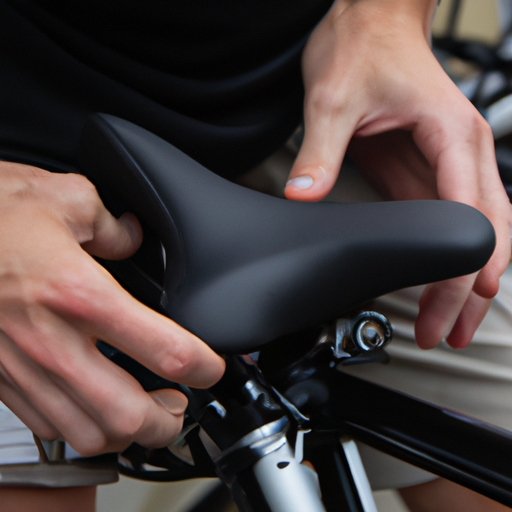What Is The Proper Technique For Descending On A Mountain Bike?
Are you an avid mountain bike rider seeking to improve your skills? If so, mastering the proper technique for descending on a mountain bike is crucial. As you navigate through steep slopes and rugged terrains, it’s essential to understand the necessary techniques to ensure a safe and exhilarating descent. In this article, we will explore the fundamental techniques that will help you conquer any mountain and enhance your biking experience. So, gear up and get ready to take your mountain biking skills to new heights!
1. Body Positioning
When it comes to descending on a mountain bike, having the right body positioning is crucial for maintaining control and stability.
1.1 Balanced Position
To achieve a balanced position, start by keeping your weight centered on the bike. This means having equal weight distribution on both the front and rear wheels. Avoid leaning too far back or too far forward, as this can throw off your balance and make it difficult to maneuver the bike effectively.
1.2 Weight Distribution
Proper weight distribution involves slightly bending your elbows and knees, allowing your body to absorb the impact of rough terrain. By keeping your knees and elbows flexed, you can maintain stability and control, especially when encountering obstacles on the trail.
1.3 Knees and Elbows
As mentioned earlier, having slightly bent knees and elbows is important for shock absorption. This helps to maintain traction on the wheels and allows you to better handle rough terrain. Keep your elbows out to the sides, giving you more control over the bike’s direction and allowing for quick adjustments as needed.
1.4 Relaxation
Lastly, it’s essential to stay relaxed while descending. Tension in your muscles can inhibit your ability to react quickly to changing trail conditions. Relax your grip on the handlebars, keeping a light and loose hold. Relaxation also helps to conserve energy, allowing you to ride longer and more comfortably.
2. Braking
Effective braking technique is vital when it comes to downhill riding, as it allows you to maintain control and slow down as needed.
2.1 Braking Before the Descent
Before you start descending, make sure to use your brakes to slow down and bring your speed under control. It’s easier to modulate your speed from a slower starting point rather than attempting to brake intensely while already descending at high speeds.
2.2 Modulating Braking Pressure
When descending, it’s important not to grab onto the brakes too forcefully. Instead, practice modulating your braking pressure, gradually squeezing the brake levers to slow down. This allows the bike’s suspension and tires to work effectively and maintain proper traction.
2.3 Proper Brake Lever Technique
To achieve optimal braking power and control, it’s crucial to use proper brake lever technique. Position your fingers on the brake levers, keeping your index and middle fingers ready to engage the brakes. Avoid gripping the brake levers too tightly, as this can cause hand fatigue and make it harder to control the bike accurately.
3. Line Selection
Choosing the right line on a descent can greatly impact your overall performance and safety.
3.1 Evaluating the Trail
Before descending, take a moment to evaluate the trail ahead. Look for potential obstacles, such as rocks, roots, or steep drops, and plan your line accordingly. Consider the terrain’s surface conditions and any potential hazards that may affect your chosen line.
3.2 Choosing the Best Line
When selecting a line, prioritize smoothness and consistency. Look for the most direct route without compromising safety and control. Opt for lines that avoid jagged rocks, deep potholes, and loose gravel, as these can disrupt your bike’s momentum and stability.
3.3 Look Ahead
Constantly scanning the trail and looking ahead is crucial for line selection. By focusing your gaze further down the trail, you can anticipate upcoming turns, obstacles, and changes in terrain. This allows you to make adjustments to your line preemptively, ensuring a smoother and more controlled descent.
4. Cornering
Proper cornering technique is essential for maintaining control and speed through turns.
4.1 Body Positioning – Outside Foot Down
When approaching a corner, shift your body weight towards the outside pedal. This helps to stabilize the bike and maintain traction during the turn. Keep your inside foot up and level with the outside pedal, allowing for smooth weight transfer as you lean into the corner.
4.2 Leaning the Bike
As you enter the corner, lean the bike and your body together in the direction of the turn. This creates a centripetal force that helps maintain stability and traction throughout the corner. Be sure to keep your head up and your eyes looking through the turn, allowing your body to follow the correct line.
4.3 Choosing the Right Apex
The apex of a corner is the point at which you come closest to the inside of the turn before exiting. By choosing the right apex, you can maximize your speed and maintain a smooth trajectory through the corner. Aim to hit the apex late, as this allows you to carry more speed and control through the turn.
5. Trail Obstacles
Navigating trail obstacles successfully requires proper technique and anticipation.
5.1 Anticipating Obstacles
Keeping your eyes on the trail ahead is crucial for anticipating and preparing for obstacles. Scan the trail, looking for rocks, roots, logs, or any other potential hazards that may impede your path. Anticipating these obstacles allows you to adjust your line and speed accordingly.
5.2 Using Body English
When encountering obstacles, use your body to maneuver the bike. Shift your weight back slightly and raise your heels, allowing the bike’s suspension to absorb the impact. This technique helps to maintain control and traction while ensuring that your wheels maintain contact with the ground.
5.3 Proper Timing
Timing is key when it comes to successfully navigating trail obstacles. Aim to approach obstacles with enough speed to carry you over them smoothly. Avoid braking abruptly or losing momentum, as this can make it more challenging to clear the obstacle. Practice timing your movements and adjusting your speed to maintain flow on the trail.
6. Speed Control
Maintaining proper speed control is vital for a safe and enjoyable descent.
6.1 Feather the Brakes
Feathering the brakes involves lightly and subtly applying brake pressure to maintain a controlled speed. Instead of fully engaging the brakes, modulate your pressure to make micro-adjustments to your speed. This technique helps to prevent skidding and allows for smoother overall control.
6.2 Use the Terrain to Control Speed
Utilizing the natural features of the terrain can assist in speed control. Leaning into berms or turns on banked sections can help you maintain speed and reduce the need for excessive braking. Additionally, using dips and rollers to your advantage can allow you to gain momentum without relying solely on pedaling.
6.3 Cadence
Maintaining a steady cadence, or pedaling rhythm, can aid in speed control. On descents, aim for a cadence that is comfortable and allows you to maintain a smooth pedal stroke without excessively accelerating or decelerating. A consistent cadence helps in maintaining control and minimizes unnecessary speed fluctuations.
7. Bike Setup
Having a properly set up bike can greatly enhance your overall riding experience and performance.
7.1 Suspension Setup
Depending on the terrain you’ll be riding, adjust your suspension settings accordingly. Experiment with different levels of compression and rebound to find the optimal setting for comfort and control. A well-tuned suspension will help your bike handle obstacles and maintain traction more effectively.
7.2 Tire Pressure
Finding the right tire pressure is essential for proper traction and control. Lower tire pressures provide better grip on rough terrain, but be mindful of avoiding pinch flats. Experiment with different pressures to find the sweet spot that offers both comfort and traction.
7.3 Gear Selection
Choosing the appropriate gear for descending can significantly impact your control and power output. Shift into a lower gear to maintain a comfortable cadence while traversing steep descents. This allows for smoother pedaling and optimized power transfer. Experiment with different gear ratios to find what works best for your riding style and the specific trail conditions.
8. Mental Focus
Maintaining a strong mental focus is just as important as physical technique when it comes to descending on a mountain bike.
8.1 Confidence and Concentration
Approach descents with confidence, but also maintain a high level of concentration. Trust in your skills and abilities, but remain alert and focused on the trail ahead. Keeping a positive mindset and being mentally prepared will help you make quick decisions and adjust to changing trail conditions.
8.2 Visualization
Visualization is a powerful tool for improving technique and control. Before descending, visualize yourself riding the trail smoothly and successfully navigating any obstacles or turns. This mental practice can enhance muscle memory and confidence, allowing you to ride with more precision and ease.
8.3 Focus on Breathing
Maintaining a consistent and controlled breathing pattern can help to manage anxiety and increase oxygen intake during descents. Focus on taking deep breaths, inhaling through your nose and exhaling through your mouth. This conscious breathing technique can help you remain calm, focused, and in control on the trail.
9. Technique Refinement
Refining your riding technique takes time and practice.
9.1 Practicing on Familiar Terrain
Start by practicing your descending skills on familiar terrain. Repeat descents on trails you know well, slowly increasing your speed and pushing your comfort zone. This familiarity allows you to focus on refining your technique without the added pressure of unfamiliar surroundings.
9.2 Gradual Progression
As you gain more confidence and skill, gradually progress to more challenging descents and trails. Push your limits incrementally to avoid overwhelming yourself. Each new challenge and successful descent will further refine your technique and expand your capabilities.
9.3 Seeking Professional Instruction
Consider seeking professional instruction or attending mountain biking clinics to enhance your technique further. Certified instructors can provide valuable feedback, guidance, and specific drills to help you improve your descending skills. Their expertise can help you refine your technique and progress at an accelerated pace.
10. Safety and Gear
Maintaining safety should always be a priority when riding a mountain bike downhill.
10.1 Helmet and Protective Gear
Always wear a properly fitting helmet when descending on a mountain bike. Additionally, consider wearing additional protective gear such as knee and elbow pads, gloves, and eye protection. These items can help mitigate injuries in case of a fall or collision.
10.2 Checking the Bike
Before each descent, take a few moments to check your bike’s components and ensure everything is in good working order. Inspect the brakes, tires, suspension, and drivetrain for any signs of damage or wear. Performing regular bike maintenance helps to prevent any unexpected mechanical failures during your ride.
10.3 Riding within Your Limits
Lastly, it’s crucial to understand and ride within your personal limits. Be honest with yourself about your skill level and choose trails that are appropriate for your abilities. Pushing your limits is important for growth, but doing so recklessly can lead to accidents and injuries. Ride responsibly and know when to dial back your speed or take a break if needed.



